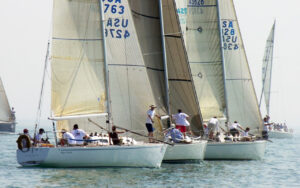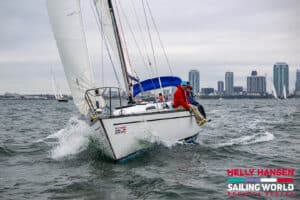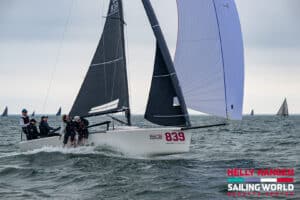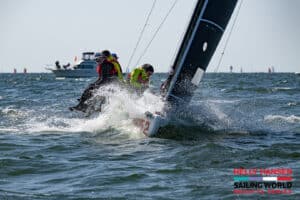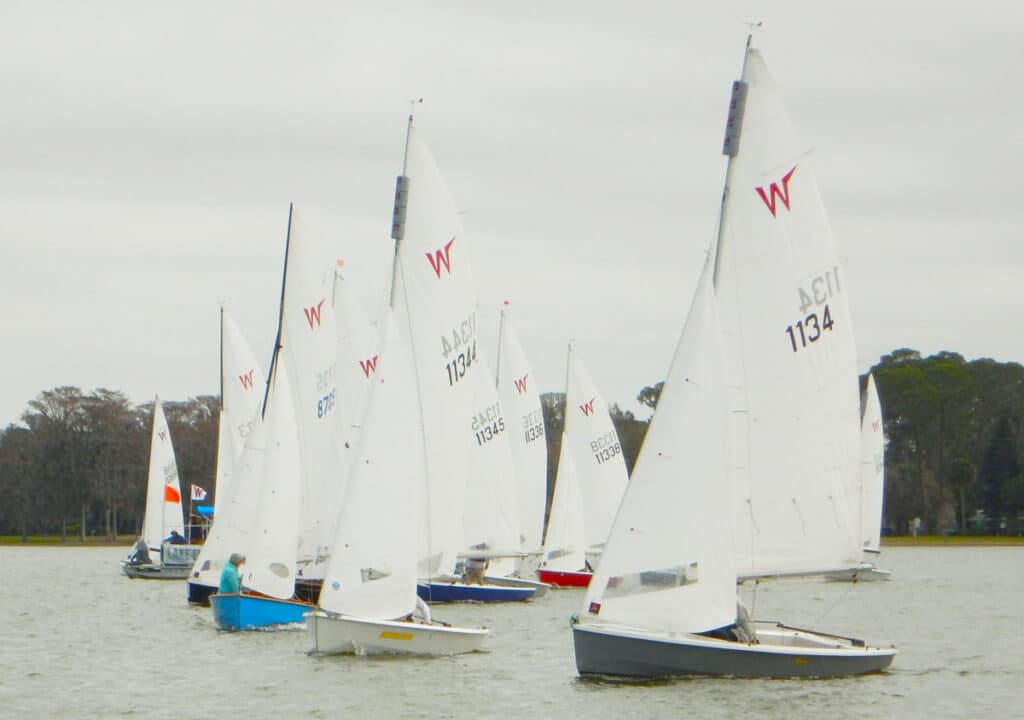
The Wayfarer dinghy has been around longer than…well, let’s just say a lot longer than the Helly Hansen Sailing World Regatta Series. By a lot. So how is it possible that this internationally-sailed 16-foot dinghy has zero street cred in the one-design hood? Ali Kishbaugh, who’s been racing Wayfarers for about seven years, isn’t sure why, but she’s hopeful the class’s debut at the Helly Hansen Sailing World Regatta in Annapolis in early May will help get the Wayfarer the attention it deserves.
According to class historians, the Wayfarer dinghy was originally designed in 1957 by Ian Proctor, the British designer and sailing hardware entrepreneur (Proctor Spars). It was, of course, an international woodie phenomenon until fiberglass came along. With molds passed to and through various builders, including Ontario’s Abbot Boats, the Wayfarer has been modernized over the decades to its current “Mark IV” version, now exclusively built by Britain’s Hartley Boats. The MK IV, aside from modern construction techniques, has improved the original design’s buoyancy and self-bailing issues, and the underdeck spinnaker launching tube now makes sets and douses much easier than from the traditional laundry basket stuff.
The 400-pound centerboarder has a big and open cockpit that can comfortably seat three adult passengers, but class racing calls for only two. It can be coastal cruised (yes, they do…), club raced, and easily handled by beginners or pushed harder by more advanced racers, like other designs of its ilk—the Flying Scot, Lightning or Buccaneer to name a few. Canada’s Parallel 45 Marine is the exclusive importer and distributor for Hartley Boats, but Wayfarers can be shipped direct to the U.S.
The majority of boats being raced, primarily east of the Mississippi, Kishbaugh says, are more the modern-day fiberglass models, but there are quite a few woodies hanging around. “They’re the same hull design, but they sail as well as the composite ones. It’s just that the rigging is a bit different on the newer ones as they’re geared more toward racing. The woodies tend to be more used for cruising, but that’s the one big thing about the Wayfarer—there are the cruisers and the racers and both do very well.”
There are mainly pockets of local Wayfarer racing, says Kishbaugh, and concentrations today are in Michigan, Connecticut, Florida and North Carolina. Kishbaugh lives in Chapel Hill, North Carolina, and with the boat always at the ready on its trailer she races her Wayfarer in regattas up and down the East Coast. The Midwinter Championship on Florida’s Lake Eustis is always a big gathering, and there’s the Eastern Championship at New Bern’s Blackbeard Sailing Club (NC), this summer’s Nationals in Rock Hall, Maryland, and then North American Championship on Lake Michigan’s Tawas Bay, which typically attracts a strong Canadian contingent.
“The thing that makes it fun and different from a lot of other dinghies is the people,” Kishbaugh says. “I could have chosen a Flying Scot, a Laser or a Lightning or any other dinghy. But it’s the people in the Wayfarer Association that are so welcoming and warm—just fun people. And then there’s the boat. Because of the hard chines, if the wind comes up, it’s a sturdy boat and it does well in strong winds. It moves reasonably well in light winds because it’s not round bottomed.”
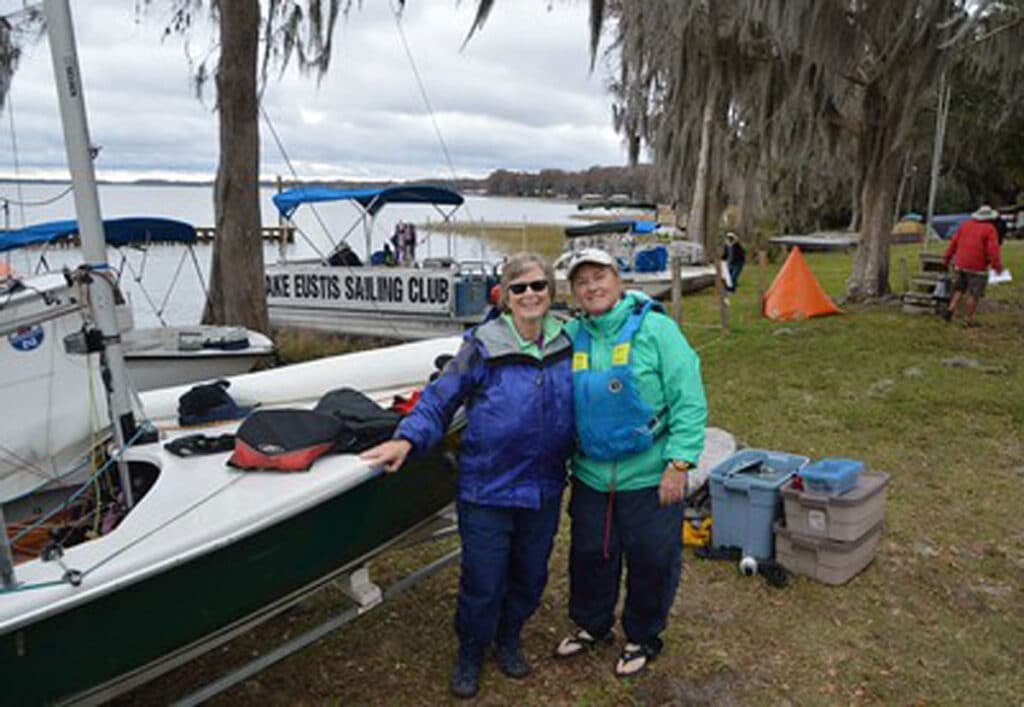
In her late 50s and fit as a fiddle, Kishbaugh, includes herself among the older sailors that are drawn to the Wayfarer, many of whom “sail very, very competitively.” Like other legacy classes, though, the class struggles to convince younger sailors to join its ranks. It frustrates her to no end that she knows firsthand that once you race a Wayfarer, you gain a greater appreciation for it.
That’s how it worked for her.
“The first time I sailed one was when somebody came to Catawba to race. I looked at it and thought it was beautiful—a really classic looking boat,” she says.
As her story goes, she crewed for somebody, loved it, and soon after, “on a little lake in Greensboro, North Carolina, I raced a regatta on a borrowed boat, with a crew I’d never met, on a lake I’d never sailed before and I did really well. So that was, for me, the moment I was hooked.”
She bought her first Wayfarer and then “quickly decided I needed a newer one that was a little more competitive.”
Given the Wayfarer has been around for 65 years, there’s not much new to be learned in the way of tricks, Kishbaugh says. “She is what she is and the way that it’s different is how you tune the boat and the sails.”
But her tips for Wayfarer boatspeed ring true for any dinghy and hints at the athleticism required. “Keeping it flat…it needs to be sailed flat because of hard chines…that’s the biggest thing. We may be an older crowd, but we definitely hike hard. Personally, I would rather have more wind than less. In heavy wind, she flies downwind.
“They’re fun boats, but we don’t get a lot of the college kids. Those who say it’s only for older folks are wrong. What I like about it is that it’s more maneuverable inside the boat. A Thistle will beat you up. Our younger sailors are into the 420s, 470s, but I think if people knew more about the boat they would be more interested in giving it a try. We just need to get more people sailing it.”
To that end, Kishbaugh says the elder statesman of the U.S. class is Jim Heffernan, who has raced Wayfarers for more than 30 years, and internationally. He was long the skipper to beat until a much younger Laser sailor named Jim Cook moved to Charlotte for work and joined the Catawba scene. Cook bought his second Wayfarer from USWA Commodore Richard Johnson, and injected his youthful enthusiasm into the class. Cook and his teammate Mike Taylor swept the Midwinter Championship races in Florida in February, but died in a boating accident in late March, an accident that shocked the tight-knit Catawba and Wayfarer family.
“Jim was an amazing sailor,” says Kishbaugh. “He was a graceful person, and was always humble. He’d walk around and give ideas and pointers if asked but didn’t push his thoughts and was just a good person and a good friend.”
Cook was registered to race the Helly Hansen Sailing World Regatta in Annapolis next month, but with his sudden and tragic passing, Kishbaugh says, the fleet will race in his honor, to showcase that the Wayfarer class is full of good people and friends like Cook.
Most of the Annapolis regatta’s participants will have likely never seen a fleet of Wayfarers, but when the racing gets underway on Friday, May 5, there will be no mistaking the half-dozen colorful hulls and spinnakers of the regatta’s oldest dinghy class.
“I’m really pushing our people to do it,” Kishbaugh says. “While it is an expensive regatta for us because of the travel and housing, it’s such a great place to sail, and I think it’s important for the class to be part of something bigger.”

